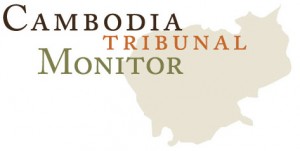The chief of security “ran terror over the entire commune”
Today’s hearing in front of the Trial Chamber of the ECCC constituted the second part of the testimony of witness Seng Khuy. The examination of this witness focused mainly on clarifications concerning geography, authority structure, and the number of people who were killed at Wat O Trakuon.
At the beginning of the session, the Trial Chamber Greffier confirmed the presence of all parties with Nuon Chea following the proceedings from the holding cell.
Geographical Clarifications
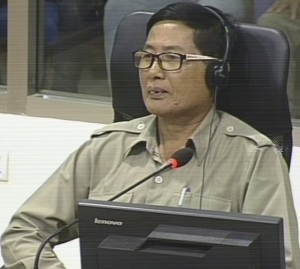
Witness Seng Khuy
Khieu Samphan Defense Counsel Anta Guissé took the floor. She started her line of questioning by inquiring about the geography of Angkor Ban commune and asked whether it was correct that there were nine villages. Mr. Seng Khuy confirmed that it was situated in Kang Meas district. There were 11 communes in Kang Meas District. He was not sure how these communes were categorized under the Khmer Rouge. He confirmed that Peam Chi Kang commune existed under the Khmer Rouge and that it was adjacent to the Angkor Ban commune. He confirmed that Wat O Trakuon was located in this district. He did not know in which Zone or Sector his commune was located. The common road the villages shared that he had mentioned yesterday was located at the river side. However, there was not much interaction between the Cham and the Khmer people who lived in the different villages. Before 1975, there were three pagodas in his commune. Ms. Guissé then asked whether it was customary to bury people within the premises of the pagoda. Mr. Khuy stated that this was not the case, but some families would decide to do so. She then asked whether it was correct that after 1975, he ate communally with 600 people. With regards to mobile units, there was a shelter built in the middle of the field. Mobile units were formed on the communal level and not the village lever. Children from the villagers and female and male single people were gathered to join the mobile unit. He could not recall the exact date when the Cham people arrived in his village but knew it took place in 1976. He did not know who assigned the Cham men and husbands from his adjacent villages to work elsewhere. Mr. Khuy replied that being sent away meant usually that they had to work at dams, dig canals or work in rice fields. This prompted Ms. Guissé to read an excerpt of his interview.[1] The witness had stated that these people were usually sent to mobile units. He could not recall this.
Leaders in Mr. Khuy’s Village and Commune
Ms. Guissé then asked whether it was correct that when the Cham men were sent away. Mr. Khuy said yes, that only around ten Cham were left in the village. Further, Mr. Khuy confirmed that Run was the chief of security. He held the position from the moment that the Khmer Rouge took power. Ms. Guissé then asked how many people accompanied Run during the arrest. Mr. Khuy stated that there were around four subordinates. He recognized one of the men who was living in Village 4. He was called Truoy Ny. He was killed after the Khmer Rouge when people “took revenge.” Ms. Guissé asked whether the security forces of the commune had a special uniform. He replied that they wore black clothing with a scarf on their neck. The scarf did not have any distinct features. When plowing the fields, Mr. Khuy sometimes saw Run coming to the rice fields. Ms. Guissé then asked whether he knew when district chief Kan took up his duty, which the witness denied knowing. Kan attended a meeting in late 1976 and that’s when he saw him the first time. The meeting was held for all villagers in Angkor Ban 3 Village. He could not remember who held the position before.
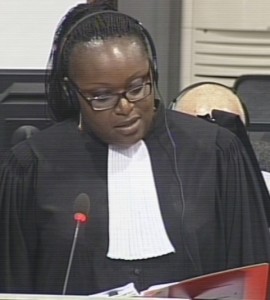
Khieu Samphan Defense Counsel Anta Guissé
Ms. Guissé then asked about Ân[2], who the witness had identified as the deputy chief of the village, and whether he knew when Ân took the position. Mr. Khuy answered that this was in 1975. He was the deputy of female village chief Nhang, who went to her home village Khong Tanyng after 1979. She asked whether it was correct that Ân came from Village 7, which Mr. Khuy confirmed. He did not know which village Kan came from. Kan had stated, however, that he was from Takeo Province in Southwest Province. When Kan chaired the meeting, Horn[3] was with him. Ms. Guissé then asked whether he made a distinction between the security chief and the militia chief. Mr. Khuy replied that the two positions were the same. Ms. Guissé then turned to the topic of Wat O Trakuon. She asked whether he knew who worked at the Security Center apart from Horn. He could not shed much light on this matter. When asked whether he had ever heard of the long sword unit, he told the Court that he noticed that there were militiamen who were the subordinates of Run who carried swords. He did not know whether militiamen in Peam Chi Kang also carried swords.
The period after 1979
Ms. Guissé inquired when the meeting took place during which the number of people who had died at Wat O Trakoun was discussed. Mr. Khuy replied that it was held around 1981 or 1982. The name of the district chief was Chhun Him. Ms. Guissé asked in which capacity the witness was invited. He replied that he was “a citizen amongst others attending the rituals. We were informed of the killings committed by the Khmer Rouge. At the time, the figure of people killed was estimated 30,000.” The district chief provided them with this figure. Ms. Guissé then inquired about his statement that the number of 30,000 people who were executed was only an estimation given by a few officials and not an official statistic.[4] Ms. Guissé asked what he meant with this statement and whether this number had therefore been challenged. After the end of the Khmer Rouge regime, public servants invited villagers to exhume the bones and skulls. These bones and skulls were collected in a stupa. Ms. Guissé then referred to a report from Report from Henri Locard.[5] In this report, Henri Locard stated that the exact number of executed people was 39008 people. Henri Locard then continued that the figures could never have been so precise, since the records had been destroyed due to the negligence and ignorance. Mr. Khuy replied that this was beyond his knowledge. There was no other meeting at Wat O Trakuon afterwards. Ms. Guissé then inquired whether there is a committee at Wat O Trakuon Pagoda. He knew one person who was part of the committee was called Thay Kuom Hoen. This person did not hold any position during the Khmer Rouge. “He was one of the slaves doing the rice farming.” Ms. Guissé then asked whether this individual lived in Village 2 or Peam Chi Kang Commune during the Khmer Rouge regime. From the period of 1975 to 1979, Thay Kuom Hoen married a woman in Peam Chi Kang commune, where he lived during the Democratic Kampuchea regime.
The Authority Structure
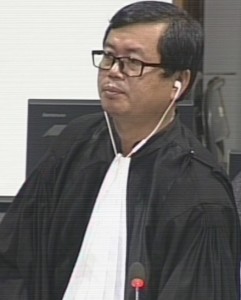
Khieu Samphan Defense Counsel Kong Sam Onn
At this point, her colleague Kong Sam Onn started his questioning. He referred to the witness’s statement,[6] where he had mentioned that he had been in charge of plowing. Mr. Khuy stated that he was assigned to plough the field and not in charge of the plowing group. There were subgroups. Under the “big-group-unit”, there were three subunits. He was part of a ten member group, who ate and worked together.
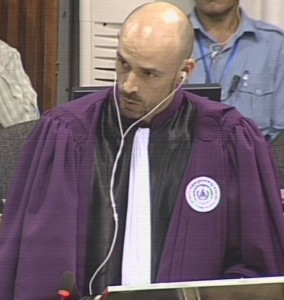
Assistant Prosecutor Andrew Boyle
Moreover, Mr. Khuy had mentioned Run as giving orders to Ân.[7] Mr. Sam Onn inquired how Mr. Khuy knew that Run gave orders to Ân. Mr. Khuy stated that Run gave Ân a verbal order to assemble the Cham. As for the authority, although the Run was in charge of the security, he had authority about other people, for example working group chiefs. He could order people to be arrested, re-fashioned or taken away and killed. If they whipped a cow or buffalo, and this was known to Run, they would be reprimanded and “maybe even taken away and killed.” He “ran terror over the entire commune.” However, Mr. Khuy did not know about the activities of Run in other places. “Of course, they would not tell us about the arrests that were made in the commune. The arrests were not made in public.” Mr. Sam Onn asked to confirm that Mr. Khuy never witnessed an arrest. At this point, Assistant Prosecutor Joseph Boyle interjected and stated that the witness had clearly stated that he had seen that Run affected arrests. The summary provided by Mr. Sam Onn was therefore incorrect. The President decided that the witness was instructed not to answer the question. Mr. Sam Onn moved on and asked whether Mr. Khuy was promoted to any position within the plowing group, which Mr. Khuy denied.
‘Killing Minorities’
Next, Mr. Sam Onn inquired about the reason for Mr. Khuy’s statement that the Khmer Rouge aimed at killing minorities. Mr. Khuy replied that he reached this conclusion because his impression was that since the Khmer Rouge mixed the Cham with Khmer people they did not want any minorities. Further, the Cham minority was sent to Wat O Trakuon. Asked how he knew that there were other arrests in the rest of the country, Mr. Khuy stated that the arrest of the Cham people took place, they said “We will kill all the Cham people and will not spare anyone.” He heard this personally at the time when the arrest was carried out.
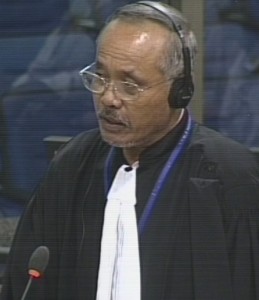
Civil Party Lawyer Hong Kim Suon
When Mr. Sam Onn asked whether Mr. Khuy had other evidence about the killing of other Cham, Civil Party Lawyer Hong Kim Suon interjected, since, according to him, the witness was not in a position to answer the question. The objection was overruled. Mr. Khuon explained that there were Cham living in the villages in Angkor Ban commune, but during the Khmer Rouge, these people disappeared. “No more Cham were living in Angkor Ban commune.” The President interjected and stated that the witness should not speculate in his answers. Mr. Kong Sam Onn then asked whether Mr. Khuy held any other positions during 1982 and 1992, when he became commune chief. Mr. Khuy replied that in 1984, he worked in the Angkor Ban commune as a member of the committee until 1987. Then, he was elected as the commune chief. When Mr. Kong Sam Onn asked which political party the witness belonged to, the President interjected and stated that this question did not belong into a courtroom. With this, Mr. Sam Onn finished the examination of the witness. The President thanked the witness and dismissed him. He adjourned the hearing, which will continue on Monday, September 14 at 9 am with the testimony of witness 2-TCW-880, and witness 2-TCW-883 being on the reserve.
[1]E3/5301, at 00622399 (FR), 00210480 (ENG), 00635166 (KH) [2] The witness explicitly stated that this person was not called An; number 2 on the list that was circulated internally. [3]An alternative spelling is Han. [4] E3/8751 00723813 (FR), 00722236 (ENG), 00716483 (KH). [5] E3/2649, at 00614111 (FR), 00208395 (ENG), 008600598 (KH). [6] E3/5301 at 00635166 (KH) 00622399 (FR) 002104181 (ENG). [7] 00635167 (KH), 00622400 (FR) 00210482 (ENG).
